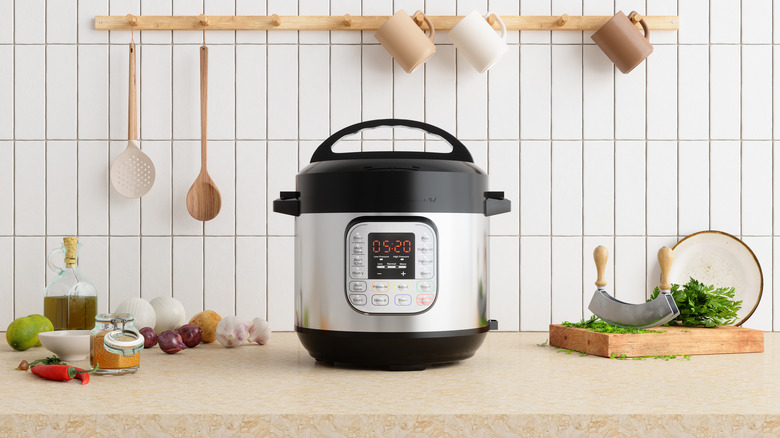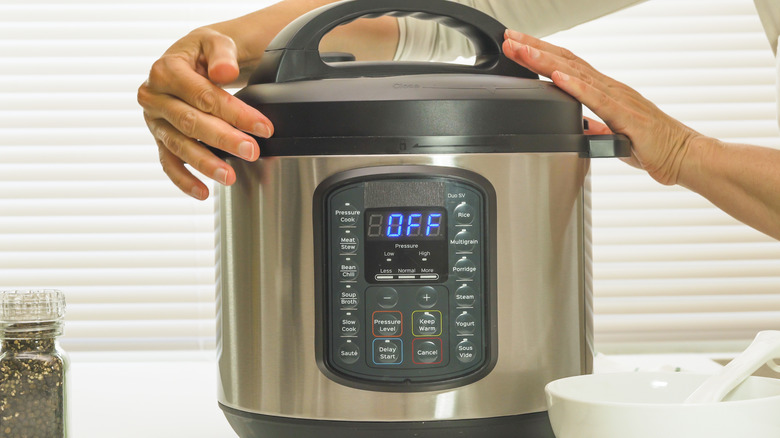The Instant Pot Cleaning Mistake That's Sure To Invite Bugs Into Your Kitchen
Properly cleaning your appliances like an Instant Pot is essential to prevent unintentionally attracting a variety of bugs to your kitchen. By thoroughly cleaning your Instant Pot after each use, you can eliminate food sources and reduce the likelihood of bugs seeking shelter or food in your kitchen. One often overlooked component of the Instant Pot that requires regular cleaning is the condensation collector. This small but crucial piece plays a significant role in trapping excess moisture produced during the cooking process. However, if not cleaned regularly, the condensation collector can become a breeding ground for mold, mildew, and bacteria. These microbial growths not only compromise the cleanliness of the Instant Pot but also create an inviting environment for bugs and pests. By cleaning the condensation collector, you prevent the accumulation of moisture and organic matter that could attract bugs to the appliance.
Bugs are attracted to areas with moisture, food, and shelter, making the kitchen an ideal habitat if cleanliness is not maintained. Spills or food residues left in the Instant Pot, including within the condensation collector, provide bugs with the necessary resources for survival and reproduction. Insects such as ants, cockroaches, and fruit flies are commonly drawn to kitchen appliances and can quickly become a nuisance if proper cleaning practices are not followed. Fortunately, regularly cleaning your Instant Pot after cooking not only helps deter bugs from the appliance but also ensures its longevity and safe use.
How to properly clean your Instant Pot
Cleaning your Instant Pot thoroughly is essential to maintain its performance and longevity while also preventing potential hygiene issues. Start by unplugging the appliance and allowing it to cool down completely. Disassemble the various components then wash the inner pot, lid, sealing ring, and steam release handle with warm, soapy water. Use a soft sponge or cloth to remove any food residues or stains. Avoid using abrasive materials that could scratch the surfaces. Rinse each component thoroughly and let them air dry or dry them with a clean towel.
Next, clean the lid thoroughly, paying special attention to the silicone sealing ring. Remove the sealing ring and wash it separately with warm, soapy water. Inspect the sealing ring for any signs of damage or wear and tear. If necessary, replace it with a new one to maintain a proper seal and prevent leakage during cooking. To clean the condensation collector, remove it from the appliance and wash it with warm, soapy water. Use a brush or sponge to reach into any crevices and ensure thorough cleaning. Dry the condensation collector completely before reassembling it with the Instant Pot.
Regularly inspect your Instant Pot for any signs of bugs or pests. Keep the appliance and its surroundings clean and free from food debris to deter pests from seeking shelter or a food source. Store the Instant Pot in a dry, well-ventilated area when not in use to prevent moisture buildup, which could attract pests.
Additional storage tips
When storing your Instant Pot, it's important to consider a few key factors to ensure its longevity and maintain its functionality. Ensure that the Instant Pot is completely dry before storing it. Moisture can lead to mold or mildew growth, compromising the appliance's performance. After cleaning, allow all components to air dry thoroughly, including the inner pot, lid, sealing ring, and condensation collector. Store the Instant Pot in a cool, dry place away from direct sunlight. Exposure to sunlight over time can cause discoloration and deterioration of the materials. Additionally, keep the Instant Pot away from heat sources or areas prone to temperature fluctuations, as these can affect its performance and lifespan.
Consider storing the Instant Pot with its lid upside down on top of the inner pot to save space and prevent dust or debris from accumulating inside the lid. Alternatively, you can store the Instant Pot with its components assembled to save time when preparing to use it again. If you plan to store the Instant Pot for an extended period, consider removing the sealing ring and storing it separately to prevent it from retaining odors or becoming misshapen. Store the sealing ring in a clean, dry place to maintain its integrity and ensure a proper seal when using the Instant Pot again. Regularly inspect the Instant Pot and its components for any signs of wear and tear. Replace any damaged or worn-out parts promptly to maintain optimal performance and safety.

